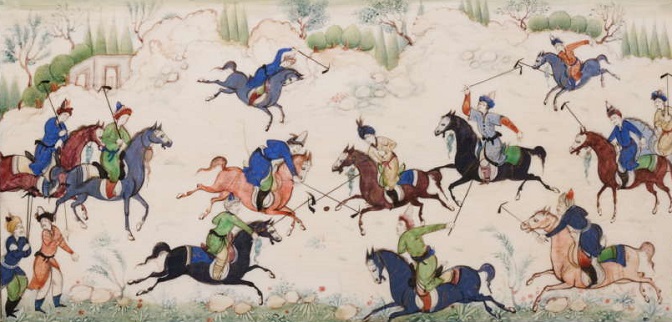Games are often compared to war, and words like “blitzkrieg” or “onslaught” are common clichés of sports journalism. As far removed as modern sports are from real combat, they have always been seen to encourage the teamwork, discipline, and physical toughness necessary to make good soldiers. One game still played today, though, was created specifically to fill army ranks with brave and skilled fighters. Polo, from its earliest origins in ancient Persia, was the training program for much of Asia’s cavalry, acquiring such prestige that it came to be known as the game of kings.

The cavalry was the pride of the Persian army from the earliest times. Much of Iran is an open plateau, ideal terrain for horses, and was long home to many superior breeds. Its geography also exposed it to invasion from the steppes to the northeast, and over the course of millennia, waves of nomads have swept across the land on horseback. This forced Persian kings to maintain a formidable force that could repel skilled barbarians who spent their entire lives in the saddle. Iranian cavalry developed in parallel to nomad warriors in an evolutionary struggle as they tried hold back the tides that rolled in from the steppes. The direction of influence between the two sides was not always clear, as each adopted tactics in response to the other. Indeed, the “Parthian shot”–an arrow fired backward from a retreating horse, used by the Persians to harass Roman armies–was characteristic of tactics used later by the Turks against the Crusaders.
Maintaining the proficiency of such a force required endless training, and it was ultimately in this that polo had its origins. The actual development of the sport is obscured by time, but its purpose was always clear. Like medieval tournaments to the west or the Mongol Great Hunt to the east, polo evolved out of organized play that served as training for the military aristocracy, gradually becoming a sport with a formalized set of rules. Even with a style of play that bears little resemblance to actual battle, it cultivated the highest levels of horsemanship in its players.

Kings who depended on battlefield victory to keep their thrones patronized the game, and it became an obsession of the Persian court. Polo fields were created near every royal palace, and kings themselves would often participate, creating a courtly culture focused on the sport. One historian said of Persian literature, “…the heroes are often celebrated for their skill at polo. Nor are their victories in war or love described in language more high flown.” Polo spread east to China, and west to Byzantium, which was Persia’s rival both on the battlefield and in the imperial splendor of its court.

Central Asian invaders from the heavily-Persianized areas of Afghanistan and Turkestan first brought the game to India as early as the 12th century. It was the Mughals of four centuries later, however, who firmly entrenched its popularity there with their lavish court patronage. India was to be the point of origin for polo’s modern form, and the British Empire was to be the mechanism for its spread. Once British officers serving in the Raj discovered the sport, they took to it with a fierce passion. Regimental teams competed for honor and glory during the long and dreary lulls between actual battlefield engagements, taking victory on the pitch as proof of superior horsemanship, much like their ancient Persian counterparts.
Those same officers brought polo back to Britain and the other parts of the British Empire, where it caught on rapidly among the upper classes. It was played largely at exclusive sports clubs, where the game maintained its traditional reputation as the preserve of the aristocracy. American patricians soon began founding clubs of their own in imitation of their cousins across the Atlantic. Elsewhere in the Americas, British cattle ranchers settling in Argentina established polo clubs, creating an enormous following with the cattle-herding gauchos of the pampas.

Polo today, in an age without kings or nobility, maintains the prestige it had in ancient times, and is played over a greater geographical extent than ever before. This prestige, along with its associations with the upper classes, has caused a new-found popularity of the sport in those rising Asian countries that first played polo long before it appeared in the West. Nor have polo’s associations with a warrior aristocracy completely disappeared. It has been a long time since horses have appeared on the front lines of combat, but the aristocratic virtues of bravery, toughness, and equestrian skill are unmistakable in its players. Even today, polo is a game of kings.
